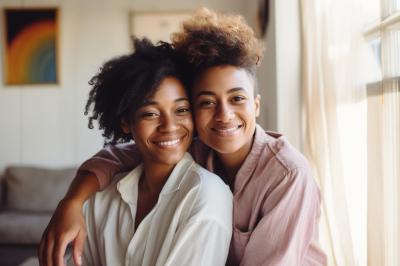Communication is the bedrock of any meaningful relationship. It is a two-way street, and only when all parties are open and honest in their interactions can an authentic connection be built. 1 2
Open communication is crucial to the development of any deepening relationship. In this article, we will look at the key components of open communication and how to build a strong, lasting connection through it.
Are communication problems getting in the way of your relationship? Learn how effective communication can help create and maintain a strong bond with your partner.
The role of open communication in relationships

Open communication is a big part of what allows relationships to deepen. This kind of communication involves discussing thoughts, feelings, and opinions openly and honestly. 3
It also involves listening to what the other person has to say and responding genuinely and respectfully. Open communication is all about understanding one another’s perspectives and finding common ground to move forward in the relationship.
When you’re both comfortable discussing difficult topics, it helps to build a stronger and more meaningful connection. This kind of communication encourages vulnerability and honesty, which helps to create trust and understanding. 4
Discover the transformative benefits of open communication with your partner. Strengthen your relationship and foster deeper connection.
11 Ways to build a connection with open communication

Open communication is an effective way of developing a deeper connection in relationships. Here are 12 ways to use open communication to build a stronger relationship:
1. Establish trust and connection through active listening
Actively listening to another person’s perspective helps create an atmosphere of trust and understanding. It is important to ensure that the other person feels heard and their feelings are considered.
To show that you’re genuinely listening, ask questions, repeat what they’ve said, and make eye contact. These small gestures can help to demonstrate that you value their opinion and are committed to building a deeper connection. 5
Improve communication with your partner using these powerful tips for practicing active listening. Enhance empathy and foster deeper connection.
2. Use “I” statements
One tip to ensure your communication is open and honest is to use “I” statements. This helps ensure that you’re expressing your thoughts and feelings without making assumptions or attributing blame.
For example, you could say, “I feel frustrated when…” instead of, “You make me feel frustrated when…”. You statements often come across as accusatory and can harm the relationship. 6
3. Honor and respect people’s boundaries
Open communication requires everyone to feel comfortable expressing their thoughts and feelings openly. It is important to respect other people’s boundaries and their wishes if they do not feel comfortable talking about a certain topic.
Respecting people’s boundaries can help to create an environment where everyone feels safe and secure to open up. Boundaries protect both parties in the relationship and help to ensure that communication is respectful and meaningful. 7
4. Use nonverbal cues for open communication
Sometimes, what you don’t say can be just as powerful as what you do. Nonverbal cues such as body language and facial expressions can effectively convey your thoughts and feelings.
For example, a smile or hug shows you’re listening and supportive. Nonverbal cues can be a great way to communicate, even when words are inadequate. 8
5. Express appreciation and gratitude
Showing gratitude and appreciation for the other person is essential to open communication. Letting them know you value their presence in your life can help create a stronger bond.
Even small gestures like saying “thank you” or expressing your admiration for something they’ve done can go a long way. Expressing appreciation and gratitude is key to building a meaningful connection. 9
6. Practice empathy and understanding
Empathy is a key part of open communication. It involves putting yourself in the other person’s shoes and seeking to understand their perspective.
Being patient and allowing others to express their thoughts without interruption or judgment is important. Practicing understanding and empathy can help to create a deeper connection.
7. Be intentional and honest
Discussions should be intentional and honest. Having a plan in mind for what topics you’d like to discuss can be helpful, but make sure that it doesn’t become scripted or rigid.
It is important to be honest and genuine in your communication and not hold back your thoughts and feelings. Allowing yourself to be vulnerable can help to build a stronger connection with the other person.
Being comfortable with being vulnerable is one of the signs of emotional intelligence in a partner. Learn key indicators to spot emotional intelligence. Discover the transformative power of truly hearing your partner.
8. Cultivate meaningful conversations
Having meaningful conversations helps to strengthen relationships. Instead of discussing surface-level topics, delve deeper into more meaningful discussions.
Because these conversations can be more emotionally taxing, ensuring everyone involved feels safe and comfortable is important. Having meaningful discussions prevent relationships from becoming stagnant or superficial.
Want to build a strong romantic relationship? Embrace open communication and learn essential tips to foster trust and intimacy with your partner.
9. Ask open-ended questions
Open-ended questions are a great way to start a conversation and foster open communication. These questions require more than a yes or no answer, encouraging the other person to open up and express their thoughts and feelings. 10
It can be helpful to come prepared with a list of open-ended questions you’d like to ask the other person. Examples could include “What do you think about…” or “How did that make you feel…?”.
10. Offer advice only when requested
When engaging in open communication, it is important to remember that you are not trying to offer advice or fix the other person’s problems. In many cases, the other person just wants to be heard and understood.
Instead of jumping in with advice, offering empathy and understanding before anything else is important. Advice is only helpful if it is requested, so make sure to wait until you are asked for your opinion. 11
11. Utilize constructive criticism
Being able to offer and receive constructive criticism is an important part of open communication. It can help to improve problem-solving skills and strengthen relationships when used correctly.
When offering constructive criticism, focus on the behavior and not the person. It is also important to remember that it should be done in a respectful and non-judgmental manner.
Likewise, when receiving constructive criticism, it is important to take it in stride and not become defensive. It is a good idea to ask for clarification if you don’t understand something and thank the other person for their input.
Open communication is essential to building and maintaining meaningful relationships. Using these tips, you can cultivate an environment where your conversations are honest and open. Master the art of communication in relationships with these essential techniques.
- Love: The Psychology of Attraction: A Practical Guide to Successful Dating and a Happy Relationship
- Single, Dating, Engaged, Married: Navigating Life and Love in the Modern Age
- The Power of Four Bases for Relationships: Can You Hit a Home Run in a Relationship?
- Communication and Relationship: A Guide to Deeper Connection, Trust and Intimacy to Improve Communication and Strengthen Your Bond as a Couple
- Couple's Bucket List: 101 Fun, Engaging Dating Ideas
Ogolsky, B. G., Monk, J. K., Rice, T. M., Theisen, J. C., & Maniotes, C. R. (2017). Relationship maintenance: A review of research on romantic relationships. Journal of Family Theory & Review, 9(3), 275-306. ↩︎
Hiew, D. N., Halford, W. K., Van de Vijver, F. J., & Liu, S. (2016). Communication and relationship satisfaction in Chinese, Western, and intercultural Chinese–Western couples. Journal of Family Psychology, 30(2), 193. ↩︎
Guerrero, L. K., Andersen, P. A., & Afifi, W. A. (2017). Close encounters: Communication in relationships. Sage Publications. ↩︎
Pagani, A. F., Donato, S., Parise, M., Iafrate, R., Bertoni, A., & Schoebi, D. (2015). When good things happen: Explicit capitalization attempts of positive events promote intimate partners’ daily well-being. Family Science, 6(1), 119-128. ↩︎
Weger, H., Bell, G. C., Minei, E., & Robinson, M. J. (2014). The Relative Effectiveness of Active Listening in Initial Interactions. International Journal of Listening, 28(1), 13–31. doi.org ↩︎
Biesen, J. N., Schooler, D. E., & Smith, D. A. (2016). What a difference a pronoun makes: I/We versus you/me and worried couples’ perceptions of their interaction quality. Journal of Language and Social Psychology, 35(2), 180-205. doi.org ↩︎
Cloud, H., & Townsend, J. (2000). Boundaries in Dating: How Healthy Choices Grow Healthy Relationships (1st ed.). Zondervan. ↩︎
Sabatelli, R. M., Buck, R., & Dreyer, A. (1982). Nonverbal communication accuracy in married couples: relationship with marital complaints. Journal of personality and social psychology, 43(5), 1088–1097. ↩︎
Buenconsejo, J. U., Fincham, F. D., & Datu, J. A. D. (2023). The perks of being grateful to partners: Expressing gratitude in relationships predicts relational self-efficacy and life satisfaction during the COVID-19 pandemic. Applied psychology. Health and well-being, 10.1111/aphw.12447. Advance online publication. doi.org ↩︎
Takemura, Y., Sakurai, Y., Yokoya, S., Otaki, J., Matsuoka, T., Ban, N., Hirata, I., Miki, T., & Tsuda, T. (2005). Open-ended questions: are they really beneficial for gathering medical information from patients?. The Tohoku journal of experimental medicine, 206(2), 151–154. doi.org ↩︎
Fitzsimons, G. J., & Lehmann, D. R. (2004). Reactance to recommendations: When unsolicited advice yields contrary responses. Marketing Science, 23(1), 82-94. ↩︎

